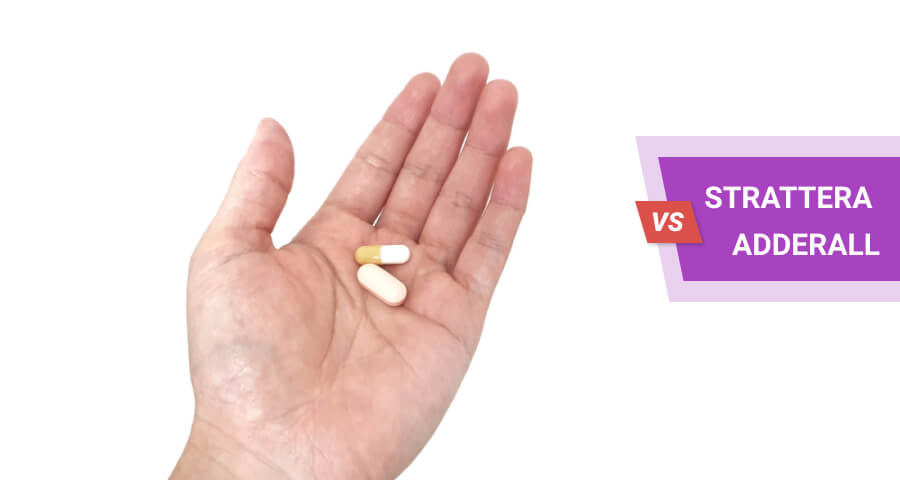
The differences between Strattera and Adderall include their classification, mechanism of action, and abuse potential. Strattera (Atomoxetine) belongs to the selective norepinephrine reuptake inhibitor class, while Adderall (amphetamine/dextroamphetamine) exists as a central nervous system stimulant.
Both medications treat ADHD in patients six years and older with similar effectiveness. However, Adderall speeds up physical processes, whereas Strattera increases norepinephrine presence in the brain without stimulation. Adderall carries high abuse potential as a controlled substance, while Atomoxetine presents minimal addiction risk.
The medications share some side effects like nausea, vomiting, dry mouth, dizziness, and headache, though Adderall typically increases sex drive while Strattera reduces it. Doctors prescribe them individually or occasionally together for optimal ADHD symptom management.
Table Of Contents:
Is Strattera The Same As Adderall
Strattera is the brand name for the medication Atomoxetine. It is a non-stimulant drug used to treat attention deficit hyperactivity disorder (ADHD). Adderall (amphetamine/dextroamphetamine) is also used in the treatment of ADHD. However, it is a stimulant drug.
Atomoxetine is not the same as Adderall, and the choice between Strattera and Adderall will depend on various factors. These factors must be discussed with the doctor to choose the most appropriate and effective treatment.
Similarities and Differences
Although these drugs are used to treat the same condition, which is ADHD, they are different in many things. Comparing Atomoxetine vs. Adderall, they have different mechanisms of action, drug class, and schedule. As they work differently in the body, they will produce different side effects.

All the similarities and differences will be discussed below.
Drug Class & Mechanism Of Action
One of the first differences between Adderall and Strattera that patients need to understand is their drug class. The first belongs to the drug class called central nervous system stimulants. This drug class is what the vast majority of ADHD medications fall under. Drugs in this class are stimulants, or uppers, increasing the rate of bodily functions.
Atomoxetine is a selective norepinephrine reuptake inhibitor or SNRI. This drug class mainly encompasses medications that treat depression and anxiety. As such, it is a unique medication in the world of ADHD treatment.
Also, separating Adderall vs. Strattera is how they act on the body. Being a stimulant, amphetamine with dextroamphetamine speeds up physical processes, with the idea being that this will allow the overactive ADHD mind to become in sync with the rest of the physical self. Atomoxetine does not cause any stimulation. Instead, it increases the presence of norepinephrine in the brain.
Uses And Age Limits
When looking at age limits with Strattera vs. Adderall, there isn’t a notable difference. Both medications are cleared for use in children with ADHD who are six years or older, though amphetamine and dextroamphetamine can be used in children as young as three with significant restrictions. They are also both meant to be used with caution in older adults.

Their uses are also quite similar. Both are drugs that are designed to treat ADHD but have numerous off-label uses. Strattera off-label uses are mood disorders, including anxiety, eating disorders, cognitive dysfunction, treatment of addictions. Likewise, amphetamine/dextroamphetamine has the following off-label uses: depression, anxiety, bipolar disorder. All of these overlap with Atomoxetine’s treatment of mood disorders.
Abuse Potential
Something that every patient should consider when looking at the difference between Adderall and Strattera is how their abuse potential differs. Amphetamine and dextroamphetamine is a drug with a high potential for abuse, which is why it is heavily controlled and part of the DEA drug schedule. Atomoxetine, on the other hand, is considered to have minimal abuse potential. In other words, it can be abused, but it is not likely, and users are not known to become physically addicted to it.
Effectiveness
Atomoxetine vs. Adderall are roughly equal in their effectiveness when treating ADHD. FDA studies show that amphetamine/dextroamphetamine addresses ADHD symptoms in some patients, though not all, and the effectiveness can taper off. Studies show the same for Strattera. As such, no patient should choose one drug over the other based on effectiveness.
Side Effects And Tolerability
When looking at Strattera vs. Adderall side effects, there is some overlap, but also plenty of key differences. For example, both Adderall and Strattera sexual side effects exist, but the first tends to increase sex drive while atomoxetine curbs it. Both drugs, however, can lead to tolerability, or the body is becoming so accustomed to the medication that the desired effects become dulled. It can result in increasing the dosage taken or switching drugs.
Other Atomoxetine Side Effects these Drugs Share Are:
- Nausea
- Vomiting
- Dry mouth
- Dizziness
- Headache
Switching From Adderall To Atomoxetine
Because Atomoxetine is considered a safer drug, many patients are interested in switching to it from stimulant ADHD medications. It is possible to make a change, but it’s necessary to know all the differences between Atomoxetine vs. Adderall before the switch.
A doctor should closely monitor any transition to a new medication. Users should be clear with their doctor about all the medicines they are already taking, including amphetamine and dextroamphetamine.

In general, doctors will not suggest a long waiting period between stopping amphetamine and dextroamphetamine and starting Atomoxetine. However, they might prefer it to be done at a time that is more suited to the patient’s needs. For example, children might be best making the switch over summer break, while adults might want to do it during a vacation from work. In most cases, it takes about six weeks for the full effects to be noticeable.
Can One Take Strattera And Adderall Together?
Doctors prescribing a Strattera Adderall combination are rare. However, it is not unheard of. In general, this is done when amphetamine/dextroamphetamine is effective but wears off too early in the day. The patient may then take a Atomoxetine dose to cover the rest of the day without risking an Adderall overdose. However, such a combination will benefit not all patients. Only a doctor can prescribe Strattera and Adderall together if a single ADHD medication doesn’t improve the condition. Patients should not attempt to access the medicines independently or use them together without explicit directions to do so.
Strattera Natural Alternatives
Apart from prescription-based medications, there are also natural alternatives for Strattera that may be used to treat ADHD. These natural remedies are mainly used complementary to Atomoxetine. The studies published in Neural Plasticity have indicated that the use of these non-prescription alternatives to Atomoxetine medication alone is not effective in treating ADHD.
Here Is a List of Natural Alternatives for Atomoxetine:
- Supplements such as melatonin, iron, magnesium, omega-3, vitamin C, and zinc
- Herbal medications like Bacopa, Ningdog, and Ginseng
- Food and diet regimen that includes eating a healthy and balanced diet and avoiding foods with additives
- Some essential oils such as lavender, rosemary, and vetiver
- Lifestyle changes that involve exercise and relaxation such as yoga, tai chi, and massage
- Behavioral or parental therapy for children
Self-medication can also be dangerous. Therefore, patients should speak to a doctor before trying any new remedies. A doctor’s prescription is essential as it provides a Strattera dosing information instructing on the amount that a patient should take.
Finding What Works Best
Adderall is an alternative to Atomoxetine medication and can be prescribed for ADHD treatment. Sometimes, even a Strattera Adderall combination may be suitable. However, only a doctor can decide on the effectiveness of the medication. Patients can only report their state changes to a doctor to help adjust a treatment.
Apart from prescription medications, there are also natural alternatives to Strattera like supplements, herbal medicines, and some essential oils, which may also be used as complementary medicine. However, self-medication with alternative meds to Atomoxetine is not advisable because natural alternatives may cause side effects to the patient, too.
Any medication can become problematic if the user approaches it incorrectly. Whether someone is addicted or just wants to stop using, they can turn to an addiction center. There, treatment for substance abuse passes under close medical supervision with suitable therapies to help the user get and stay clean.
Hope Without Commitment
Find the best treatment options. Call our free and confidential helpline
Most private insurances accepted
Find Drug Rehabilitation Centers Near You Anywhere In the US
Addiction Resource team has compiled an extensive list of the top drug rehabilitation facilities around the country. Use our locator tool to find the best centers near you.
Page Sources
- Dadashova, R., & Silverstone, P. H. (2012). Off-label use of atomoxetine in adults: is it safe?. Mental illness.
- Upadhyaya, H. P., Desaiah, D., Schuh, K. J., Bymaster, F. P., Kallman, M. J., Clarke, D. O., ... & Allen, A. J. (2013). A review of the abuse potential assessment of atomoxetine: a nonstimulant medication for attention-deficit/hyperactivity disorder. Psychopharmacology, 226(2), 189-200.
- ADDERALL® (CII). 2007.
- Prasad, S., & Steer, C. (2008). Switching from neurostimulant therapy to atomoxetine in children and adolescents with Attention-Deficit Hyperactivity Disorder. Pediatric Drugs, 10(1), 39-47.
- STRATTERA®(atomoxetine HCl). Eli Lilly and Company. 2007.
- Treuer, T., Gau, S. S. F., Méndez, L., Montgomery, W., Monk, J. A., Altin, M., ... & Dueñas, H. J. (2013). A systematic review of combination therapy with stimulants and atomoxetine for attention-deficit/hyperactivity disorder, including patient characteristics, treatment strategies, effectiveness, and tolerability. Journal of child and adolescent psychopharmacology, 23(3), 179-193.
- Ahn, J., Ahn, H. S., & Cheong, J. H. (2016). Natural product-derived treatments for attention-deficit/hyperactivity disorder: safety, efficacy, and therapeutic potential of combination therapy. Neural plasticity, 2016.


 Reviewed by:
Reviewed by:  Written by:
Written by: 

 FindTreatment.gov
FindTreatment.gov